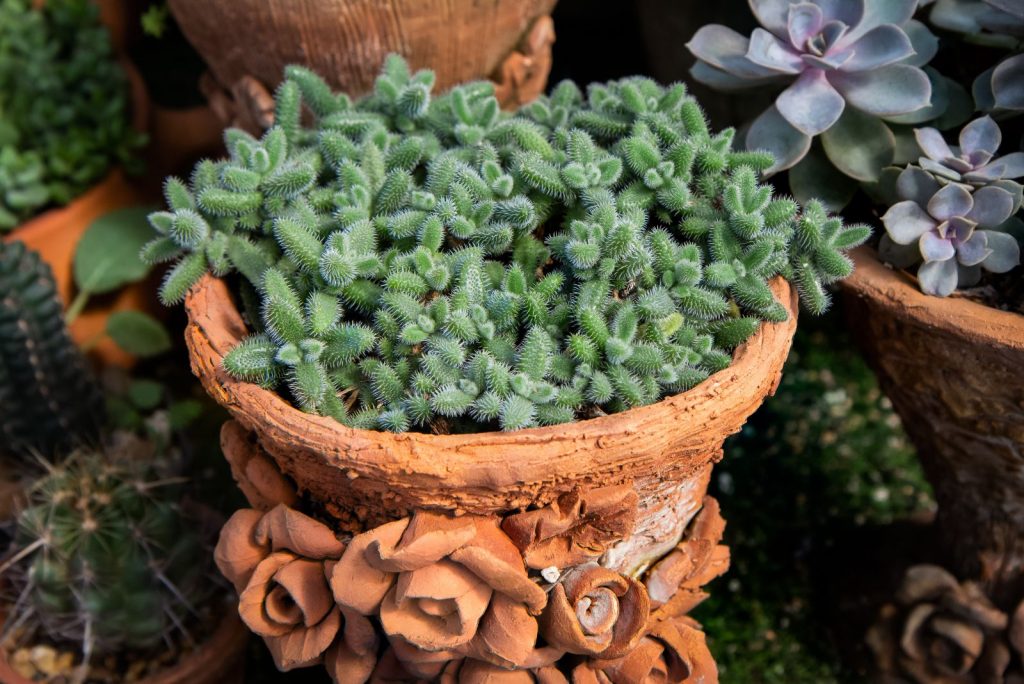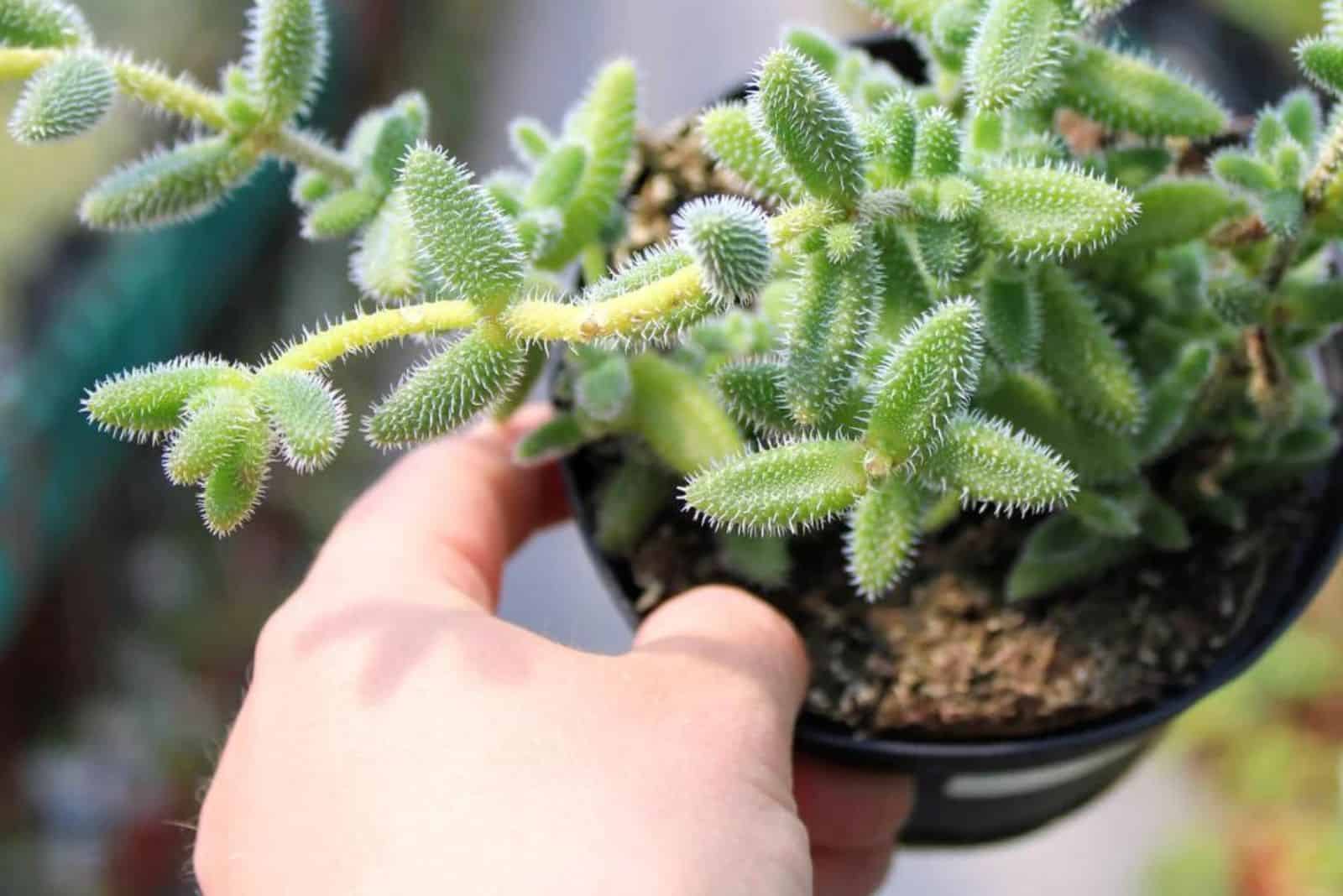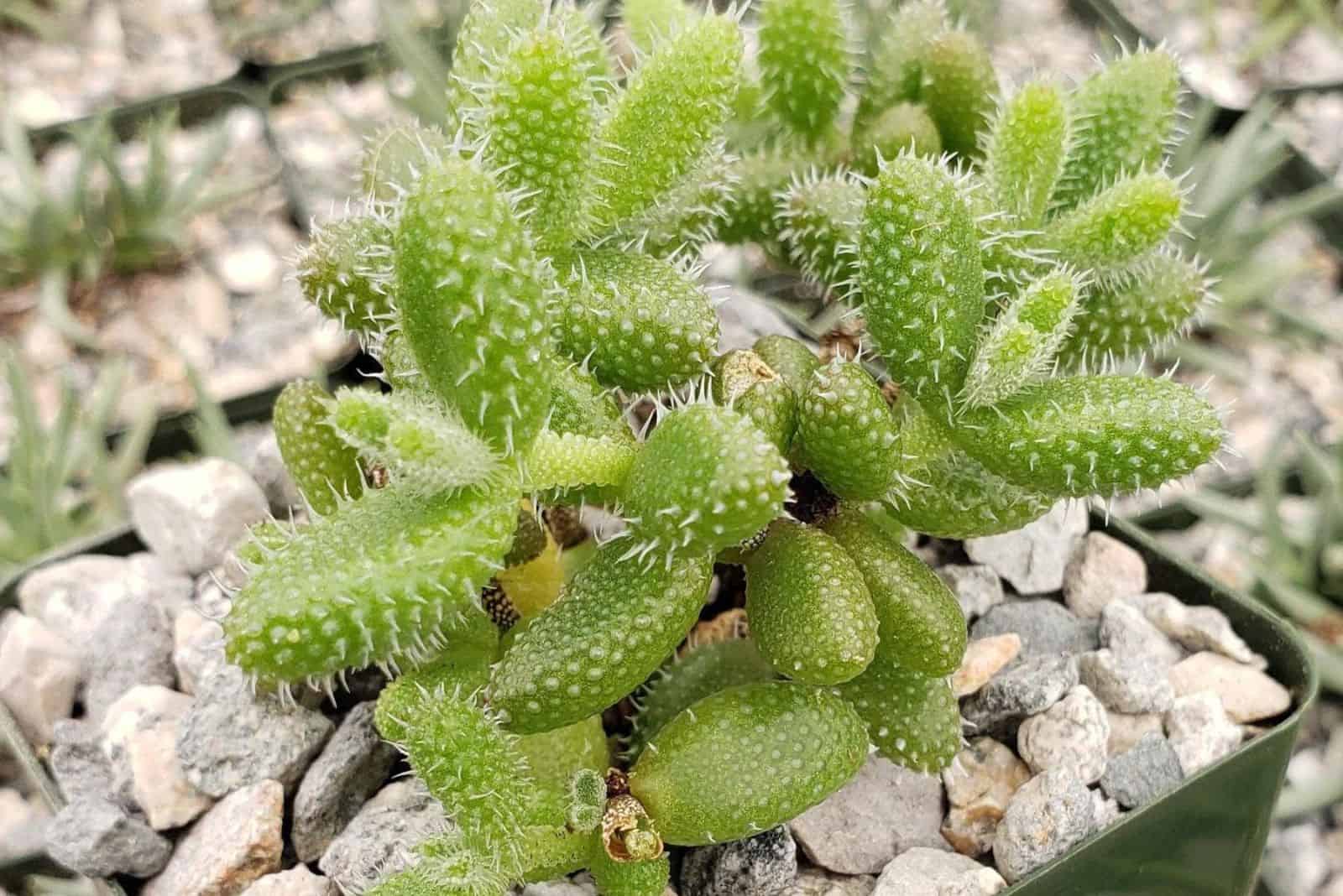The gardening world is full of surprises and just when you think you’ve seen it all, something new and unusual pops up. For me, the Pickle plant was one of the biggest surprises.
No, it’s not a type of gherkin and definitely doesn’t taste like it; it’s actually a houseplant with many excellent features.
Let’s dive into the world of this captivating plant, discover its characteristics, and unveil the secrets behind successful cultivation!
What Is The Pickle Plant?
Surprisingly, this plant is a succulent and it’s native to South Africa. It’s scientifically referred to as Delosperma echinatum and belongs to the Aizoaceae family.
Why the Pickle plant? The leaves are responsible for this name. They’re fleshy and their glossy surface is covered in tiny lumps and hairs.
This is where the similarities between gherkins and Pickle plants end. Hairs on the Pickle plant aren’t prickly but rather soft.
Interestingly, when you expose these hairs to bright light, they’ll look like icicles. This is the reason why this plant also goes under the name Ice plant. I kinda like the Pickle plant name more.
This Delosperma plant won’t exceed 18 inches, making it perfect for smaller spaces. However, bear in mind that the size of succulent plants depends on many factors, such as light and pot size.
The Pickle plant has a spreading habit in its natural environment.
Is The Pickle Plant Low-Maintenance?
One of the most common questions I get about plants is if they’re easy to maintain. If you grow any succulent plants, I believe you’ve noticed that these plants don’t need much to thrive.
The Pickle plant isn’t an exception. Once you learn the perfect light level and understand its watering requirements, you’ll get a thriving plant with little effort.
I always say that succulents are perfect for those gardeners who don’t know how to spare water and end up overwatering most of their plants.
If you’re one of those gardeners, the Pickle plant is perfect for you. Let’s see its basic needs in detail!
How Much Water Does It Need?
Some of you may hate me for saying that there’s no strict watering schedule for any plant. But you would hate me more if I gave you a fixed schedule and you killed your plant.
Why is it so hard to determine when the plant needs water? The amount and watering frequency the Pickle plant needs depends on these key factors:
1. Humidity and temperature in your household
2. Soil type
3. The size of your plant
4. The size of the container
A rule of thumb is to water your Pickle plant when its soil dries out completely. This ‘rule’ will give you the best results and there will be no risk of overwatering your prized plant.
Remember, too much water in the growing medium is the main cause of a dying succulent.
All you need to do is check the soil moisture every few days. Use your finger or a wooden stick to determine the moisture content. Other things which can help you figure out if it’s time for watering are bright soil color (light brown) and a lightweight pot.
I recommend checking soil moisture once per week during the summer because temperatures are high, and plants display new growth and lose water faster.
On the other hand, check the soil every 2-3 weeks during the winter months because your Pickle plant is dormant and temperatures are lower.
Slika
Why does the Pickle plant have low watering needs? Its leaves, just like the leaves of all succulents, are fleshy and have the ability to store water. This is a defense mechanism they created to survive drought in their natural environment.
If you suspect that there’s some water in the soil, it’s better to wait for two to three more days and then proceed with watering. Underwatering is less likely to kill your Pickle plant.
What’s The Best Soil Type?
A suitable soil type will help you avoid watering issues in your Pickle plant. The soil must be porous and free-draining because heavy and compact soil types retain water, which is something we want to avoid.
The easiest thing to do is purchase a ready succulent/cactus soil mix. They’re cost-effective and perfect for beginner growers who haven’t tried their hands at soil mixing.
If you have experience or would like to try to make your own soil, mix 2 parts horticultural sand with 2 parts potting soil and 1 part perlite (or pumice).
These ingredients will ensure all the nutrients and drainage your Pickle plant needs.
Pickle Plant Light Requirements
There’s one golden rule when it comes to light exposure for the Pickle plant: put it in the sunniest window in your home.
These plants enjoy bright light and will need at least 6-8 hours of exposure to direct sunlight.
If you can’t ensure this amount of light for your Pickle plant, don’t worry, it won’t kill it but you should know that insufficient light can lead to etiolation in succulents.
This basically means that your Pickle plant will extend to the light source and may not look as lush as it’s supposed to.
You can either get used to it or purchase and install artificial lights.
Can You Grow Pickle Plants Outdoors?
This is a bit of a tricky question because the answer is yes, you can grow your Pickle plant outdoors, but you need to know a few things.
These plants aren’t cold hardy and you can plant them in the ground only if you live in warm climates. Additionally, you must plant it where it can receive as much bright light as possible.
If you live in cooler climates, you can take your Pickle plant outdoors during the summer and then take it indoors to overwinter.
Pay attention to pests if you keep your Pickle plant outdoors. Closely inspect it before taking it indoors and if there are any pests, get rid of them immediately.
Does The Pickle Plant Bloom?
The Pickle plant generates blossoms during the warmer months. However, if you’re expecting an abundance of blossoms, that’s not gonna happen.
The flowers are daisy-like, tiny, and yellow and they typically stay open for about a month. If you grow your Pickle plant outdoors, you can expect the flowers to last a little bit longer.
Blossoms will occur if you provide the plant with the right conditions. First, you need to allow it to go through dormancy during the winter months.
Second, you need to keep it in a room with slightly lower temperatures. And third, you need to let the soil dry out entirely between waterings.
The Pickle plant is definitely a plant you won’t see in every household. It’s a rare species with an unusual look so if your collection needed something special, the Pickle plant is the perfect choice.




